John Hawkins Worksheets
Do you want to save dozens of hours in time? Get your evenings and weekends back? Be able to teach about John Hawkins to your students?
Our worksheet bundle includes a fact file and printable worksheets and student activities. Perfect for both the classroom and homeschooling!
Resource Examples
Click any of the example images below to view a larger version.
Fact File
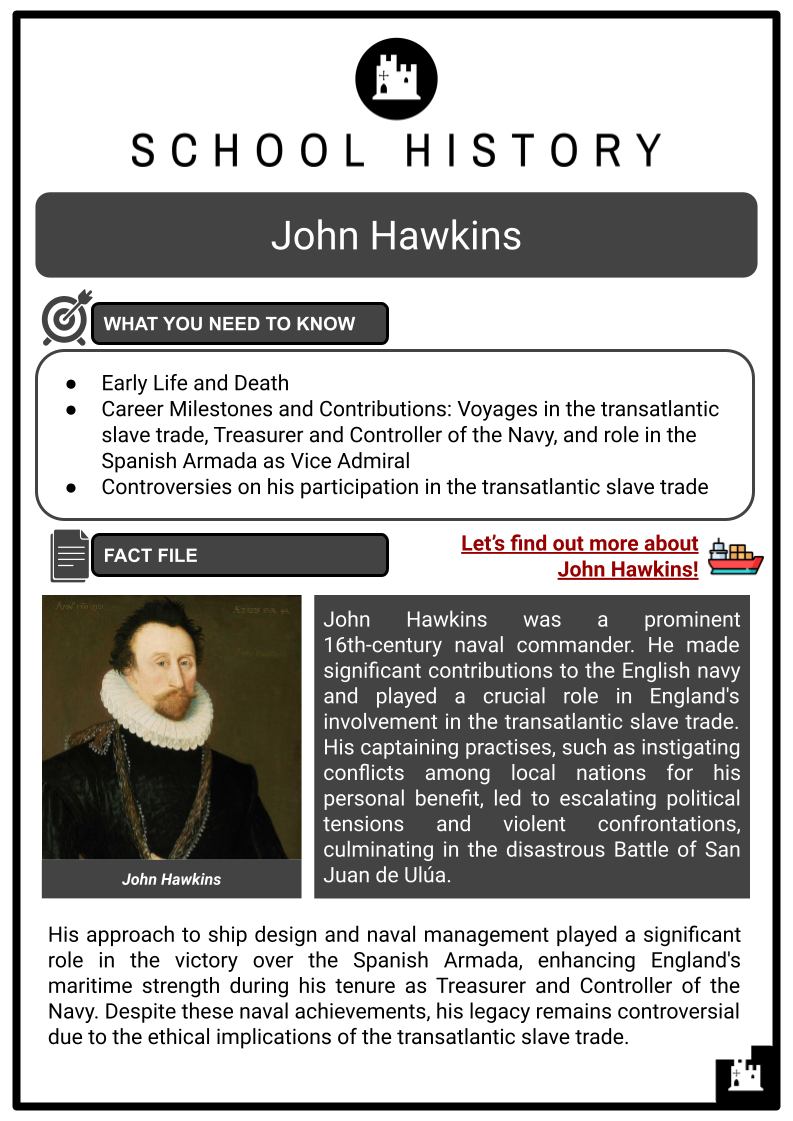
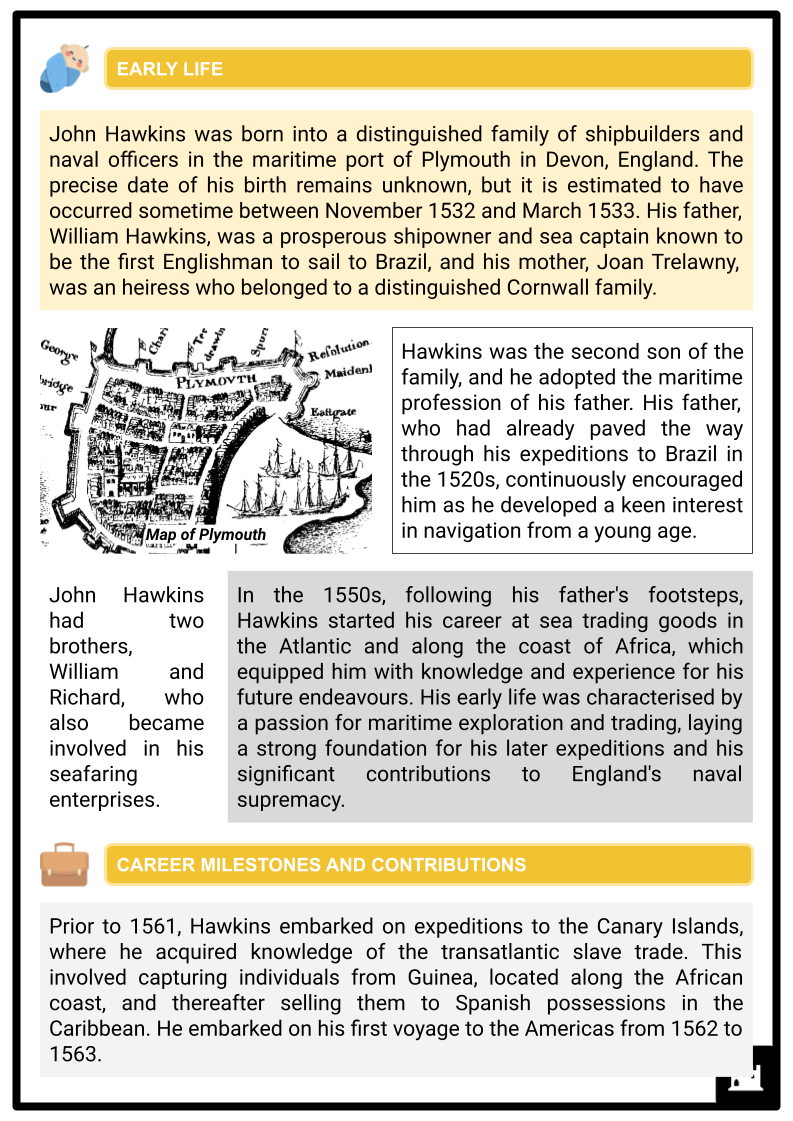
Student Activities
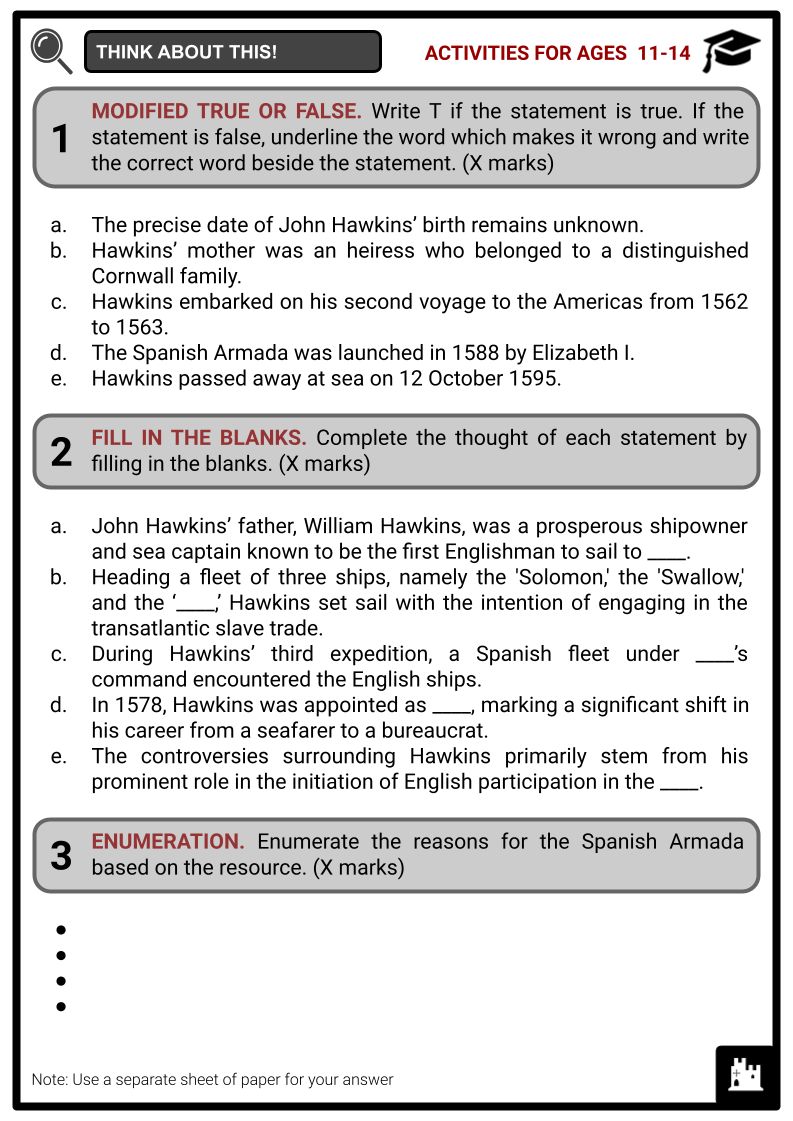
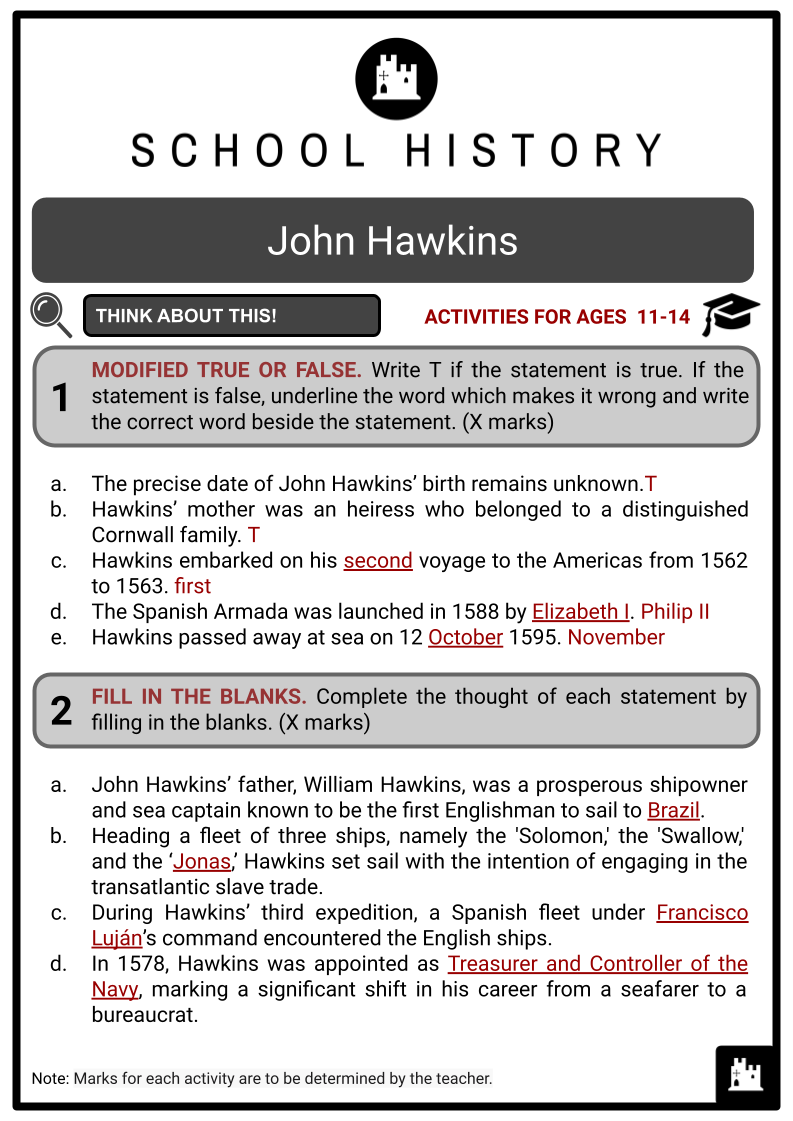
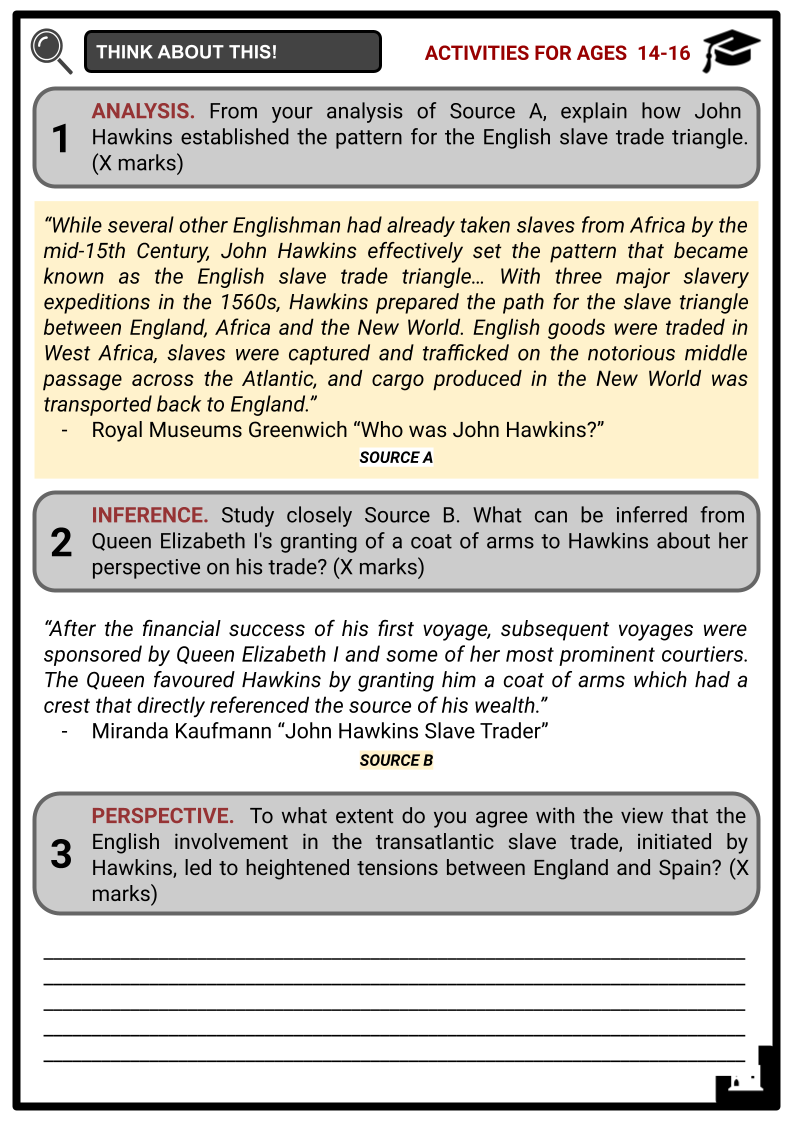
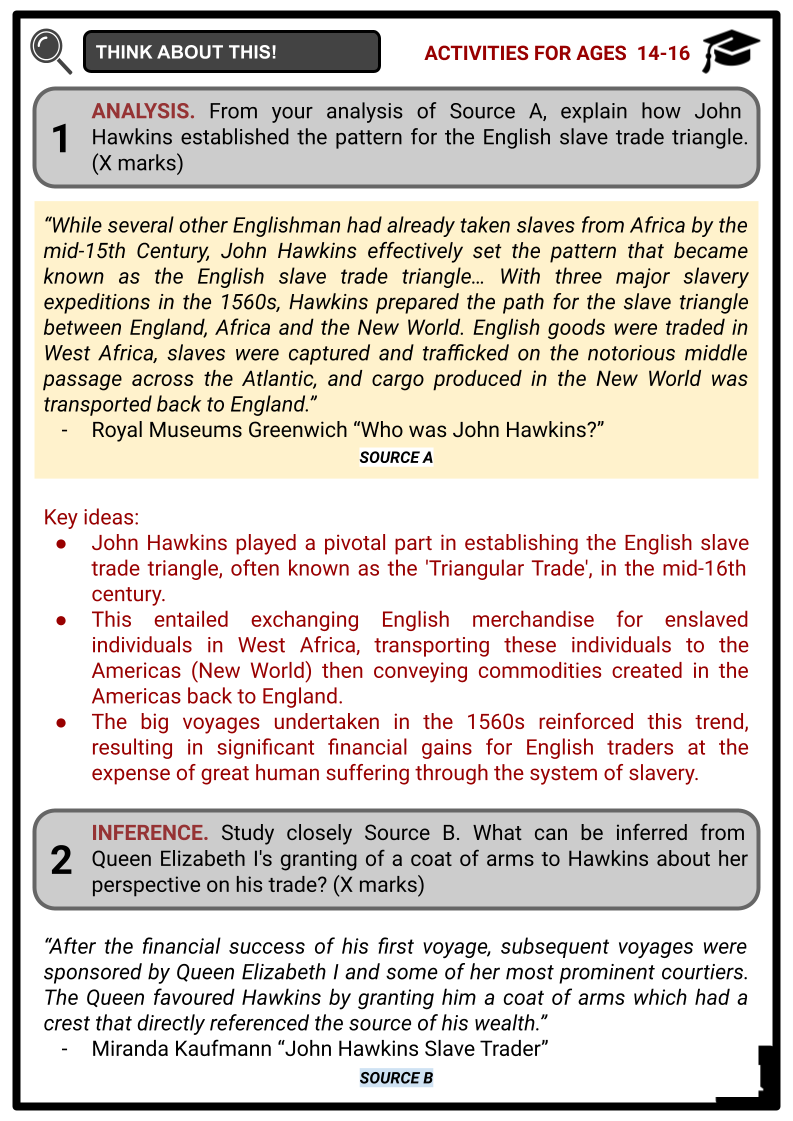
Summary
- Early Life and Death
- Career Milestones and Contributions: Voyages in the transatlantic slave trade, Treasurer and Controller of the Navy, and role in the Spanish Armada as Vice Admiral
- Controversies on his participation in the transatlantic slave trade
Key Facts And Information
Let’s know more about John Hawkins!
John Hawkins was a prominent 16th-century naval commander. He made significant contributions to the English navy and played a crucial role in England's involvement in the transatlantic slave trade. His captaining practises, such as instigating conflicts among local nations for his personal benefit, led to escalating political tensions and violent confrontations, culminating in the disastrous Battle of San Juan de Ulúa.
His approach to ship design and naval management played a significant role in the victory over the Spanish Armada, enhancing England's maritime strength during his tenure as Treasurer and Controller of the Navy. Despite these naval achievements, his legacy remains controversial due to the ethical implications of the transatlantic slave trade.
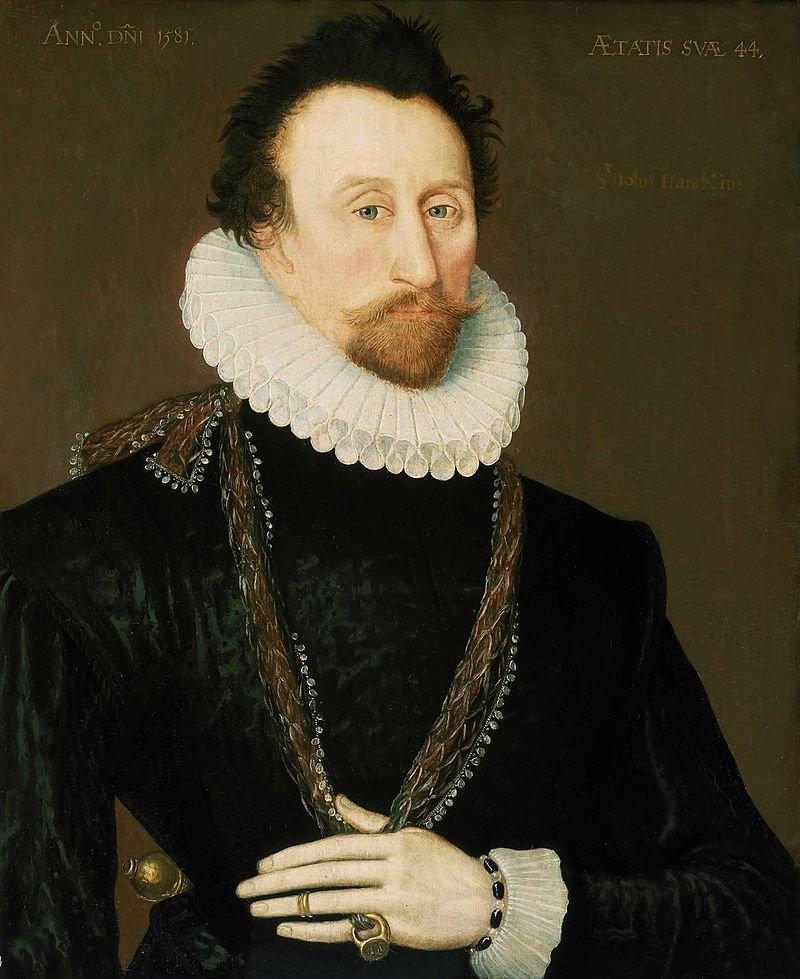
EARLY LIFE
- John Hawkins was born into a distinguished family of shipbuilders and naval officers in the maritime port of Plymouth in Devon, England. The precise date of his birth remains unknown, but it is estimated to have occurred sometime between November 1532 and March 1533. His father, William Hawkins, was a prosperous shipowner and sea captain known to be the first Englishman to sail to Brazil, and his mother, Joan Trelawny, was an heiress who belonged to a distinguished Cornwall family.
- Hawkins was the second son of the family, and he adopted the maritime profession of his father. His father, who had already paved the way through his expeditions to Brazil in the 1520s, continuously encouraged him as he developed a keen interest in navigation from a young age.
- John Hawkins had two brothers, William and Richard, who also became involved in his seafaring enterprises.
- In the 1550s, following his father's footsteps, Hawkins started his career at sea trading goods in the Atlantic and along the coast of Africa, which equipped him with knowledge and experience for his future endeavours. His early life was characterised by a passion for maritime exploration and trading, laying a strong foundation for his later expeditions and his significant contributions to England's naval supremacy.
CAREER MILESTONES AND CONTRIBUTIONS
- Prior to 1561, Hawkins embarked on expeditions to the Canary Islands, where he acquired knowledge of the transatlantic slave trade. This involved capturing individuals from Guinea, located along the African coast, and thereafter selling them to Spanish possessions in the Caribbean. He embarked on his first voyage to the Americas from 1562 to 1563.
- Heading a fleet of three ships, namely the 'Solomon,' the 'Swallow,' and the 'Jonas,' Hawkins set sail with the intention of engaging in the transatlantic slave trade. The group journeyed to Sierra Leone in West Africa, where they instigated wars among the local nations and captured the defeated—estimated to be over 300 individuals—as enslaved.
- On the deck of the English fleet, these captives endured deplorably inhumane conditions as they were transported across the Atlantic. Upon reaching the Americas, Hawkins circumvented Spain's laws prohibiting foreign traders, successfully selling the African men, women, and children into slavery.
- Economically, the voyage was a success. The profits gleaned attracted the attention and tacit support of the British Crown and set the stage for more state-sanctioned journeys to capture enslaved people, effectively birthing English participation in the transatlantic slave trade. Hawkins is largely acknowledged as the pioneering English businessman who successfully capitalised on the Triangular Trade. He engaged in the exchange of English commodities for enslaved individuals in Africa, subsequently selling them in the Americas and procuring foreign goods to be sold in England upon his return.
- Hawkins quickly left for his second voyage in 1564, spurred on by the first voyage's financial success. With four ships now under his command, including the 700-ton 'Jesus of Lübeck', Hawkins set sail again for Africa with the aim of captivating a larger number of African individuals. Similar to his first voyage, local conflicts were instigated to capture individuals with minimal resistance.
- Upon reaching the Americas, Hawkins utilised the same cunning and tactical negotiation skills to evade Spanish legislation and sell the enslaved individuals to the burgeoning colonies. The second voyage turned out to be a greater economic success than the first, increasing both Hawkins' personal wealth and standing but also reinforcing England's commitment to the triangle trade. The profits from this voyage helped consolidate support from England's investors and the monarchy, leading to the institutionalisation of the transatlantic slave trade.
- The third expedition that Hawkins undertook in 1567 marked a significant departure from the previous two. While retaining the intentions of capturing and trading enslaved people, this voyage witnessed a drastic turn of events that would profoundly impact not only Hawkins' career but also relations between England and Spain. This journey raised the stakes and highlighted the volatile, risky nature of the transatlantic slave trade, which was becoming more and more marred by political tensions and violent encounters.
- With a fleet of six ships, Hawkins, together with his cousin Francis Drake, embarked on another journey to West Africa, where he used similar tactics of instigating disputes among local nations and capturing the defeated individuals. However, during the return leg of the voyage, his fleet came upon a Spanish port at San Juan de Ulúa, where they sought refuge from a brewing storm despite knowing that their presence might provoke the Spanish.
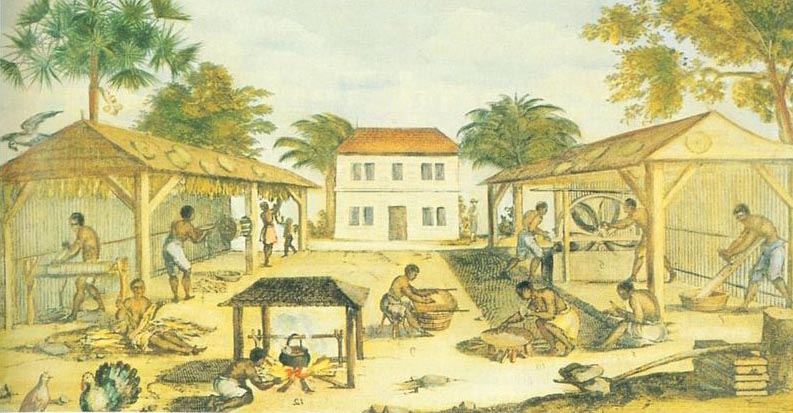
- A Spanish fleet under Francisco Luján's command encountered the English ships. Instead of a peaceful cohabitation, the suspicious and tense atmosphere led to the outbreak of the Battle of San Juan de Ulúa—a violent confrontation that saw the English fleet suffer significant losses, with only two ships, including Hawkins' flagship, managing to escape.
- Following the disastrous confrontation, Hawkins and his men experienced severe hardships, including a shortage of supplies and attacks by local indigenous populations. Only a minor portion of the crew managed to return to England. The disastrous incident fueled Hawkins' lifelong animosity towards the Spanish and marked a transition in his career from profitable, albeit unethical, entrepreneurial voyages towards state-backed privateering against Spanish interests.
- In 1578, Hawkins was appointed as Treasurer and Controller of the Navy, marking a significant shift in his career from a seafarer to a bureaucrat. As Treasurer and Controller of the Navy, he was instrumental in revitalising and strengthening England's naval fleet.
- He undertook several transformative measures in the English naval sector, most notably introducing the 'race-built galleon.' These galleons had a lower centre of gravity, and their compact design increased their stability in the ocean. Their introduction into the English navy was a game changer, making the fleet more equipped for high-seas combat.
- Moreover, Hawkins implemented advancements in artillery technology. He recognised the potential of naval artillery and championed the integration of superior firepower into ship design. He advocated for the strategic use of these vessels in naval confrontations, combining superior manoeuvrability and firepower. By 1587, the Navy consisted of 23 ships and 18 pinnaces as a result of his reforms.
- Relations between England and Spain declined by the end of the 16th century due to a combination of events such as the English piracy against Spanish ships, Elizabeth I of England's support for the Dutch rebellions, and the execution of the Catholic Mary, Queen of Scots.
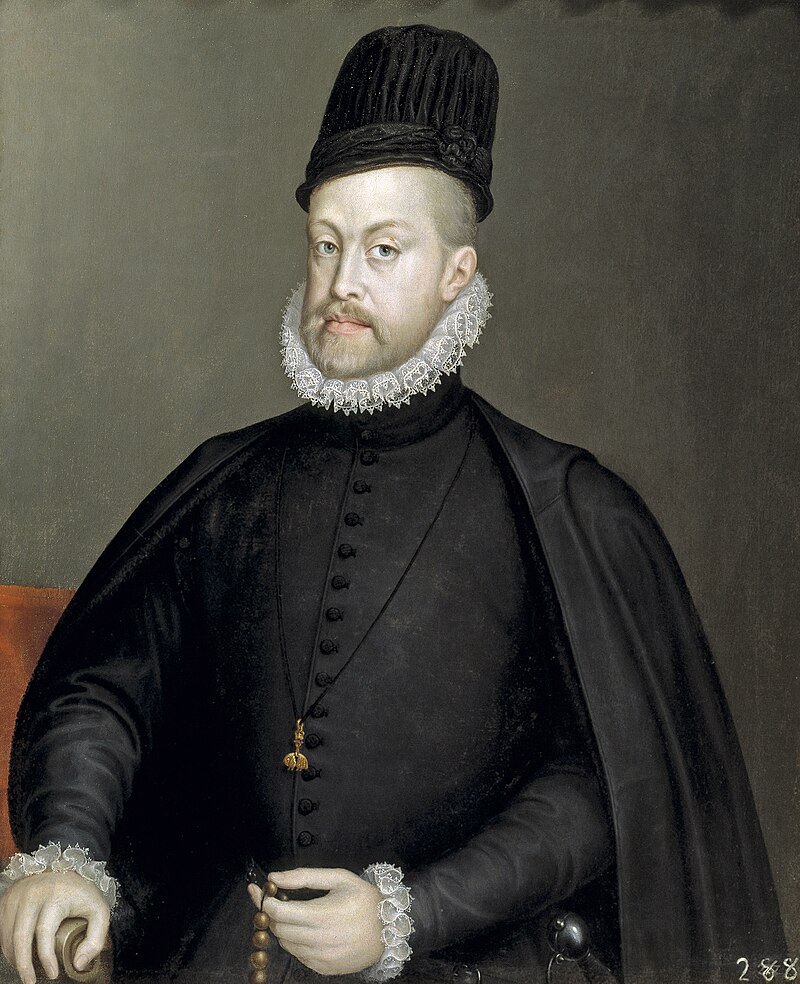
- Philip II of Spain, who initially favoured the Protestant queen, made it his objective to conquer England and restore it to Catholicism. He launched the 1588 Spanish Armada, which was fought by the Royal Navy of Elizabeth I in the English Channel.
- Reasons for the Spanish Armada:
- Philip II wanted to restore Catholicism in England. He had the backing of the pope, who excommunicated Elizabeth I in 1570.
- As a Catholic power whose Spanish Empire had been expanding, Philip II wanted to conquer England and lead its monarchy since the figurehead of Catholicism in England, Mary, Queen of Scots, had been executed.
- Philip II wanted to halt the attacks of English privateers against Spanish galleys returning from the New World.
- Philip II wanted to stop the English aid to Dutch rebels and French Protestants.
-
- When the Spanish Armada occurred in 1588, Hawkins served as Vice Admiral. Despite facing overwhelming odds given the formidable size and reputation of the Spanish fleet, the English side emerged victorious.
- The improved design and performance of the English ships, as well as the tactical strategies employed, played a crucial role in this outcome.
- Hawkins developed the English galleon, which was lower, sleeker, and consequently much faster and more manoeuvrable. The fleet had 200 smaller cannons that could fire over long distances and were quick to reload. Additionally, 14,000 men on board were armed with longbows. These contributions underscore Hawkins’ role as a distinguished naval administrator and strategist. His efforts significantly boosted England's naval supremacy in the later part of the 16th century.
- In his final years, Hawkins continued his maritime endeavours, participating in the expeditions of 1595 aimed at attacking Spanish holdings in the Americas. His final voyage turned out to be a catastrophe, however, resulting in failures and losses both personally and at a national level.
CONTROVERSIES
- The controversies surrounding Hawkins primarily stem from his prominent role in the initiation of English participation in the transatlantic slave trade. Historically recognised as the first English trader to profit significantly from the trade, Hawkins' business expeditions led to the commodification of human lives on an industrial scale.
- Hawkins' maiden voyage in 1562 marked the beginning of English involvement in this notorious trade. He, along with his crew, captured over 300 individuals from Sierra Leone and transported them to the Americas, where they were sold into slavery. This practice blatantly violated both ethical norms and Spain's territorial claims.
- His subsequent voyages further institutionalised the English engagement in the transatlantic slave trade, leading to worsening conditions for the captured Africans and escalating international tensions. Apart from the profound ethical concerns found in these activities, they also contributed to growing hostilities between England and Spain, particularly highlighted by the disastrous Battle of San Juan de Ulúa during his third voyage.
- Despite the evident economic gains, this practice left a dark mark on history, opening a horrific chapter of human exploitation, suffering, and long-lasting socio-economic imbalances. As a result, Hawkins' legacy remains marred by controversy, with his naval reforms and contributions to England's maritime strength being overshadowed by the moral implications of his involvement in the transatlantic slave trade.
DEATH
- Hawkins met his demise during an expedition in 1595 again with his cousin, Francis Drake. The expedition was intended as an attack on Spanish holdings in Panama and the Caribbean. The mission was fraught with problems from the start. Their plans for a surprise attack were hindered when the Spanish court was alerted about their intentions, leading to formidable defensive preparations.
- Battling a resilient Spanish force, disease, and numerous setbacks resulted in a lack of progress for the English fleet. In this gruelling environment, Hawkins, who was in his late fifties, fell seriously ill. His deteriorating health, coupled with the unsuccessful attacks, marked a tragic end to his life as he passed away at sea on 12 November 1595.
- Hawkins' significant contributions to the development of England's naval power are crucial aspects of his legacy, but his part in the transatlantic slave trade makes it complex and contentious. The circumstances of his death starkly contrast his lifetime achievements and embody the unpredictable and risky nature of maritime life during that era.
Image Sources
- https://upload.wikimedia.org/wikipedia/commons/thumb/0/00/John_Hawkins.JPG/800px-John_Hawkins.JPG
- https://upload.wikimedia.org/wikipedia/commons/a/a5/1670_virginia_tobacco_slaves.jpg
- https://upload.wikimedia.org/wikipedia/commons/thumb/2/2d/Portrait_of_Philip_II_of_Spain_by_Sofonisba_Anguissola_-_002b.jpg/800px-Portrait_of_Philip_II_of_Spain_by_Sofonisba_Anguissola_-_002b.jpg
Frequently Asked Questions
- Who was John Hawkins?
John Hawkins was an English naval commander, shipbuilder, and privateer best known for his involvement in the early English slave trade and as a sea captain during the Elizabethan era.
- What was John Hawkins's contribution to the English slave trade?
John Hawkins played a significant role in initiating the English involvement in the Atlantic slave trade. In 1562, he made the first known English slave voyage, transporting African captives to the Americas.
- What was John Hawkins's relationship with Queen Elizabeth I?
Hawkins had a close relationship with Queen Elizabeth I. He served as treasurer and comptroller of the Royal Navy and played a vital role in developing England's naval capabilities during Elizabeth's reign.
